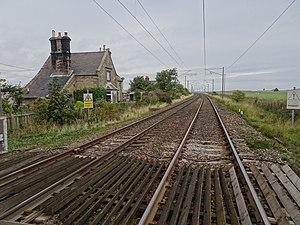Goswick railway station served the hamlet of Goswick, Northumberland, England from 1870 to 1964 on the East Coast Main Line.
Goswick | |
|---|---|
 The site of the station, looking northwest to Scremerston, in 2018 | |
| General information | |
| Location | Goswick, Northumberland England |
| Coordinates | 55°42′23″N 1°55′43″W / 55.7063°N 1.9286°W |
| Grid reference | NU046459 |
| Platforms | 2 |
| Other information | |
| Status | Disused |
| History | |
| Original company | North Eastern Railway |
| Pre-grouping | North Eastern Railway |
| Post-grouping | LNER British Railways (North Eastern) |
| Key dates | |
| November 1870 | Opened as Wind Mill Hill |
| 1 January 1898 | Renamed Goswick |
| 5 May 1941 | Temporarily closed to passengers |
| 7 October 1946 | Reopened |
| 15 September 1958 | Closed to passengers again |
| 10 August 1964 | Closed completely |
History
editThe station first opened on 6 March 1850 but it wasn't open to passengers. The earliest evidence of passenger use was on 11 May 1858, but only for those attending the Goswick farm sale. It was included in the Newcastle Journal as Windmill Hill on 6 January 1853 but only excursion trains stopped here. Regular passenger service began in November 1870.[1]
The station's name was changed to Goswick on 1 January 1898.[2] It was situated at a level crossing of an unnamed minor lane 2 miles (3.2 km) east from the A1. It was close to the Berwick-upon-Tweed Golf Club. A goods siding was northwest of the down platform. However, a mission room was established which joined the goods siding. This was established at the end of the nineteenth century, and this eventually became Wind Mill Hill Presbyterian Church. The station closed to passengers in late 1941 after a strafing attack by the Luftwaffe when a local passenger train was in the station. Six people suffered minor injuries, but the station was reopened on 7 October 1946, although Sunday services were not restored.[3] An accident occurred on 26 October 1947 near the station when the Flying Scotsman derailed due to the driver failing to stop at the signals and the guard not reading the notice of the diversions at Haymarket TMD. The station house was used as a triage for the injured and the church at the goods sidings was used as a mortuary for the 28 people that were killed.[4] Three other accidents have occurred here, in August 1907, March 1922, and October 1953.[5]
The station closed to passengers on 15 September 1958,[1] and completely on 10 August 1964 after the last goods service on 10 April 1964 had stopped.[6][7][2]
References
edit- ^ a b Quick, M E (2002). Railway passenger stations in England, Scotland and Wales - a chronology. Richmond: Railway and Canal Historical Society. p. 202. OCLC 931112387.
- ^ a b Hoole, Kenneth (1985). Railway stations of the North East. Newton Abbot: David and Charles. p. 167. ISBN 0-7153-8527-5.
- ^ Gray, Adrian (2013). East coast main line disasters. York: Pendragon Publishing. p. 81. ISBN 1899816194.
- ^ Barrington-Ward, Robert, ed. (27 October 1947). "Engine and eleven coaches derailed near Berwick". The Times. No. 50902. p. 4. ISSN 0140-0460.
- ^ "Wide search for "goswick" :: The Railways Archive". railwaysarchive.co.uk. Retrieved 21 November 2023.
- ^ "Disused Stations: Goswick". Disused Stations. Retrieved 13 February 2017.
- ^ "Goswick railway station (site),... © Nigel Thompson :: Geograph Britain and Ireland". Geograph. Retrieved 27 February 2021.
| Preceding station | Historical railways | Following station | ||
|---|---|---|---|---|
| Beal Line open, station closed |
North Eastern Railway East Coast Main Line |
Scremerston Line open, station closed | ||